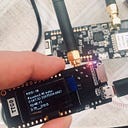NEO-6M Howto: change serial data rate via serial interface (boost from 9.6k to 115k) — for NEO-6, NEO-7, NEO-8
TLDR: it’s possible using internal command, even if docs say not
As you already noticed, we are able to tweak NEO GPS receiver to increase rate of measurements, from 1sec to 0.1sec, which gives us 10x drop in latency, but also 10x times of data must be sent using default serial protocol from device. This might be a problem, because some NMEA message packs (GPGSV) are quite large themselves — example shown at the end of the first article.

However, NEO supports much faster data rate on it’s interfaces, just the serial default is set to = 9600, because it looks like “fits all solution”.
But the problem is, main doc spec states that serial data can’t be changed via serial itself, once it was started. Sounds like nonsense for you? Me too.
PUBX CFG-PRT message looks like this:

And here comes the baud rate:

Let’s assume we are not tweaking txReady bits yet, so our hand-crafted packet will look like this:
// Send a packet to the receiver to change baudrate to 115200.
void changeBaudrate() {
// CFG-PRT
byte packet[] = {
0xB5, // sync char 1
0x62, // sync char 2
0x06, // class
0x00, // id
0x14, // length
0x00, //
0x01, // payload
0x00, // payload
0x00, // payload
0x00, // payload
0xD0, // payload
0x08, // payload
0x00, // payload
0x00, // payload
0x00, // payload
0xC2, // payload
0x01, // payload
0x00, // payload
0x07, // payload
0x00, // payload
0x03, // payload
0x00, // payload
0x00, // payload
0x00, // payload
0x00, // payload
0x00, // payload
0xC0, // CK_A
0x7E, // CK_B
};
sendPacket(packet, sizeof(packet));
}sendPacket() just writes bytes to HardwareSerial
void sendPacket(byte *packet, byte len) {
for (byte i = 0; i < len; i++)
{
GPS.write(packet[i]);
}
}There will be necessary to re-init HardwareSerial to use new baudrate:
GPS.begin(9600, SERIAL_8N1, 34, 12); //default mode
changeBaudrate();
delay(100); GPS.flush();
GPS.begin(115200, SERIAL_8N1, 34, 12); //new 115k boost modeVoila! Now we have much faster Serial — 12x faster, to use with our tweaked GPS measurements rate, which are already 10x faster than defaults.
Hope that helps.
Some additional notes, may be important:
Note 1: always test your device if it actually capable of 115k. NEO chip is still a chinese random especially when faked, and other schematic may differ between versions;
Note 2: if your device have battery power — just like T-Beam, for instance — please note that CPU chip reset (as well as RST, and IDE code upload’ reset) are not resetting NEO GPS module, it’s still on power and operational. In particular, data options you set earlier might affect your UART port rates.
